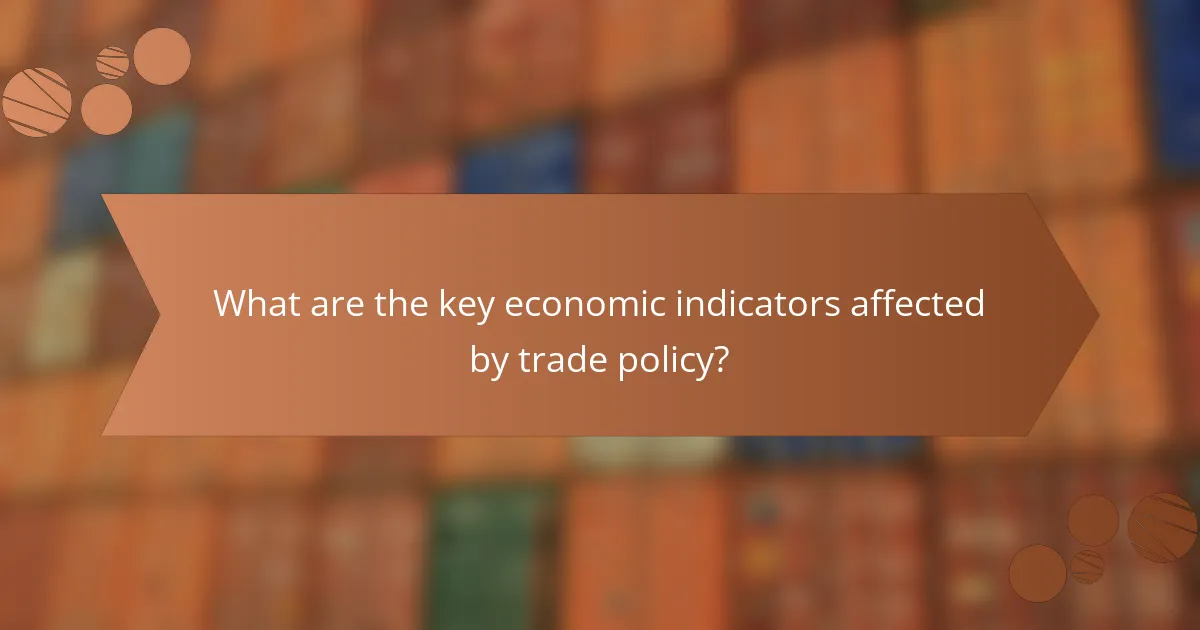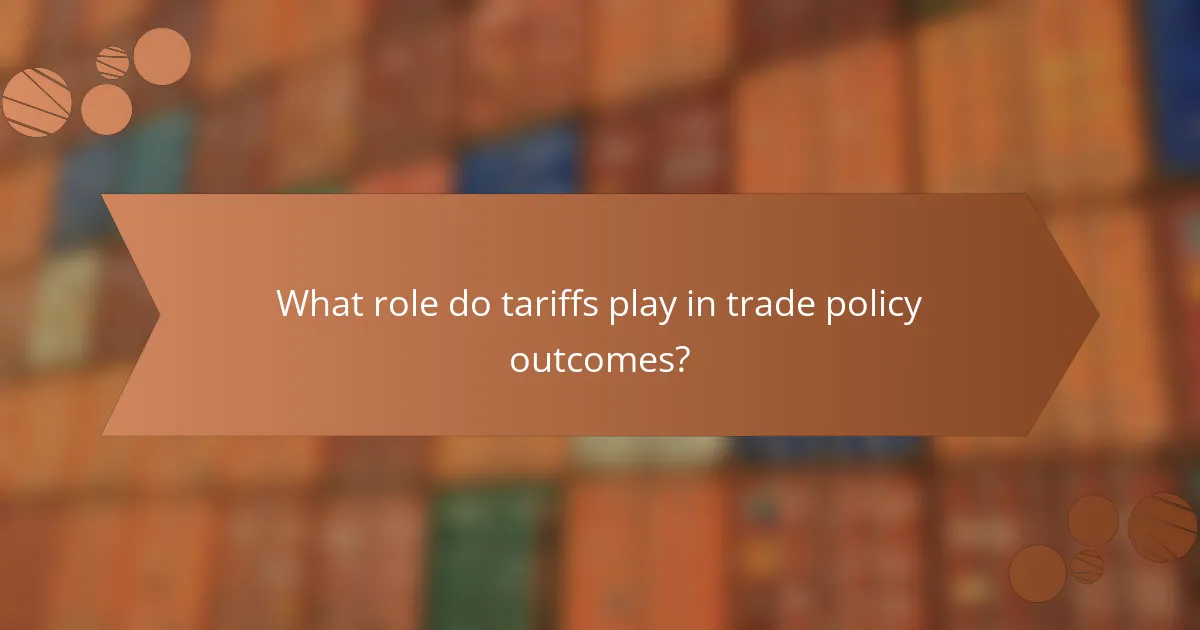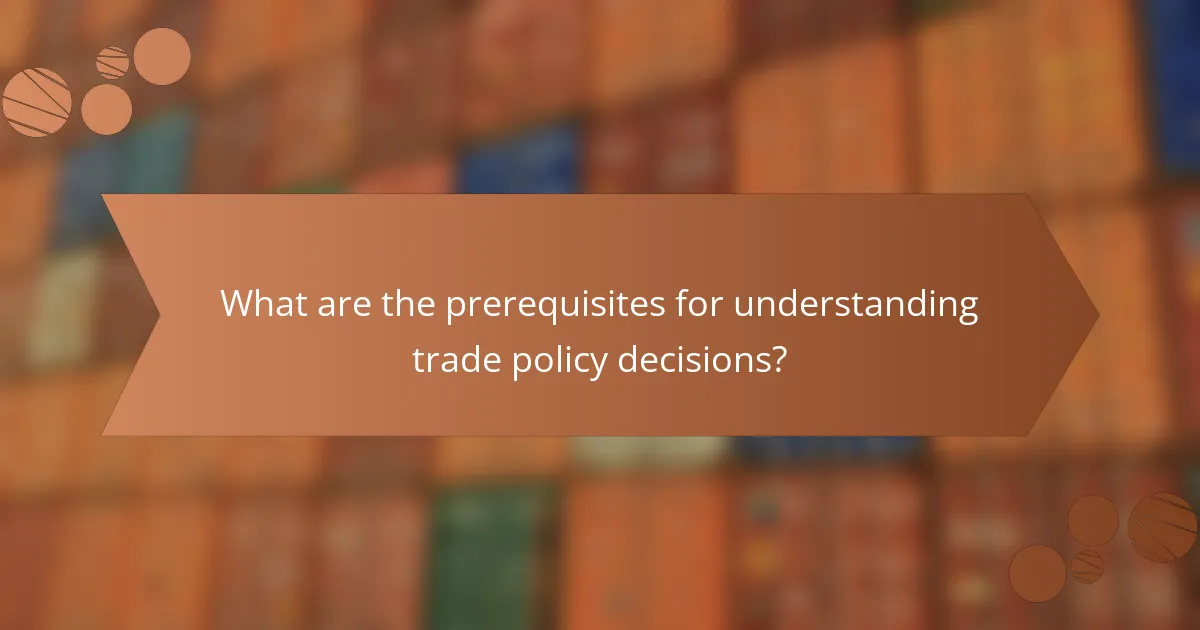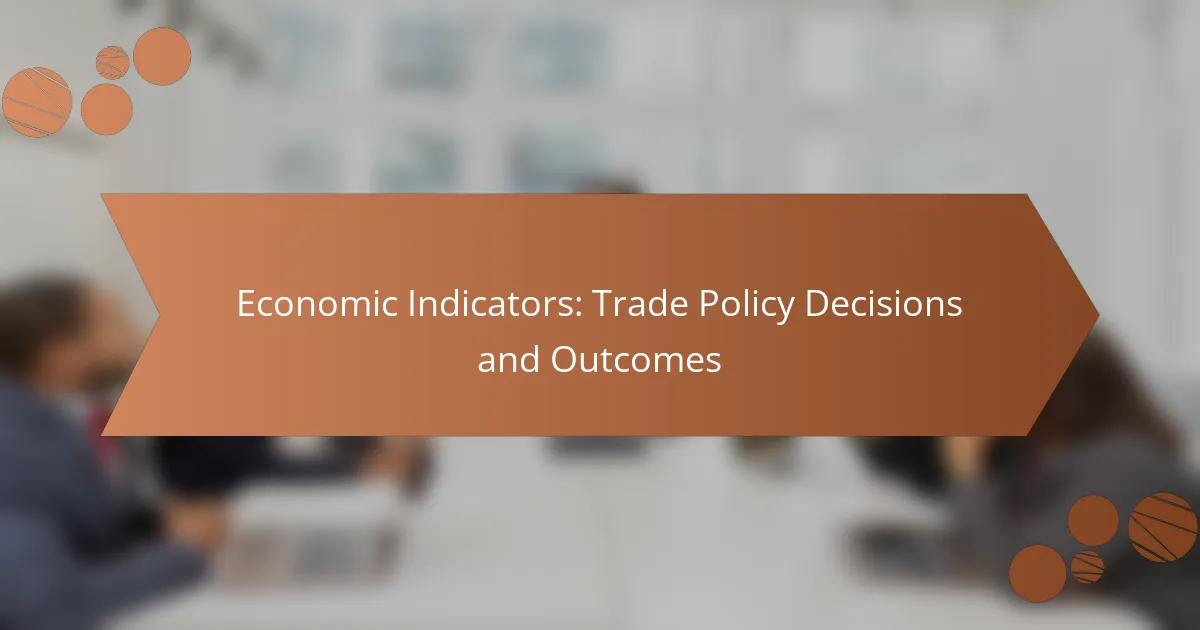Trade policies play a crucial role in shaping economic indicators such as GDP growth, inflation rates, and employment levels. By modifying tariffs and engaging in trade negotiations, policymakers can significantly impact the overall economic landscape, guiding businesses and influencing consumer behavior.

How do trade policies impact economic indicators in the United States?
Trade policies significantly influence key economic indicators in the United States, including GDP growth, inflation rates, and employment levels. By adjusting tariffs and negotiating trade agreements, policymakers can directly affect the economy’s performance and stability.
Trade agreements influence GDP growth
Trade agreements can lead to increased GDP growth by reducing barriers to trade, thus promoting exports and imports. When countries enter into free trade agreements, they often experience a boost in economic activity as businesses gain access to larger markets.
For example, the United States-Mexico-Canada Agreement (USMCA) aims to enhance trade among the three nations, potentially increasing GDP by several billion dollars over time. Businesses can benefit from lower tariffs and improved market access, which can stimulate investment and innovation.
Tariffs affect inflation rates
Tariffs can lead to higher inflation rates by increasing the cost of imported goods. When tariffs are imposed, businesses often pass these costs onto consumers, resulting in higher prices for everyday items.
For instance, recent tariffs on steel and aluminum have raised prices in various sectors, including construction and manufacturing. This inflationary pressure can reduce consumer purchasing power and slow down economic growth if sustained over time.
Import/export volumes shift employment rates
Changes in import and export volumes can significantly impact employment rates in the United States. An increase in exports typically leads to job creation in export-oriented industries, while higher imports can sometimes result in job losses in domestic sectors unable to compete.
For example, a surge in exports of agricultural products can create jobs in farming and related industries, while an influx of cheaper foreign goods may lead to layoffs in local manufacturing. Policymakers must balance these effects to support overall employment stability.

What are the key economic indicators affected by trade policy?
Trade policy significantly influences several key economic indicators, including Gross Domestic Product (GDP), unemployment rates, and the Consumer Price Index (CPI). These indicators reflect the overall economic health and can guide policymakers in making informed decisions.
Gross Domestic Product (GDP)
GDP measures the total value of goods and services produced in a country and is directly impacted by trade policy. When trade barriers are reduced, GDP often increases due to enhanced export opportunities and lower import costs, stimulating economic growth.
For example, a country that lowers tariffs on imported goods may see a rise in GDP as consumers benefit from lower prices and increased variety. Conversely, restrictive trade policies can lead to a decrease in GDP by limiting market access and reducing competitiveness.
Unemployment rates
Unemployment rates are influenced by trade policies that affect job creation and loss in various sectors. When trade agreements promote exports, they can lead to job growth in industries that are competitive internationally.
However, sectors that face increased competition from imports may experience job losses. For instance, if a country opens its market to cheaper foreign goods, domestic manufacturers may struggle, leading to higher unemployment in those industries.
Consumer Price Index (CPI)
The Consumer Price Index (CPI) tracks changes in the price level of a basket of consumer goods and services, and trade policy can significantly affect these prices. Lower tariffs and trade restrictions can lead to a decrease in consumer prices as imports become cheaper.
For example, if a country reduces tariffs on electronics, consumers may see lower prices for these goods, positively impacting the CPI. Conversely, trade policies that increase costs for imports can lead to higher consumer prices, contributing to inflationary pressures.

How can businesses adapt to changing trade policies?
Businesses can adapt to changing trade policies by implementing flexible strategies that allow them to respond quickly to new regulations and tariffs. This involves reassessing supply chains, adjusting pricing, and investing in market research to stay competitive and compliant.
Diversifying supply chains
Diversifying supply chains is crucial for businesses facing shifting trade policies. By sourcing materials and products from multiple countries, companies can mitigate risks associated with tariffs and trade restrictions. For instance, a manufacturer might source components from both Asia and Europe to avoid disruptions from policy changes in a single region.
Consider establishing relationships with suppliers in different markets. This not only spreads risk but can also lead to cost savings and improved negotiation power. Regularly evaluate the geopolitical landscape to identify potential new suppliers that align with your business needs.
Adjusting pricing strategies
Adjusting pricing strategies is essential when trade policies change, especially if tariffs increase costs. Businesses should analyze their pricing models to determine how much of the increased costs can be passed on to consumers without sacrificing sales. A common approach is to implement gradual price increases rather than sudden hikes.
Additionally, consider offering promotions or discounts on certain products to maintain customer loyalty during transitions. Monitoring competitor pricing can provide insights into market expectations and help in making informed pricing decisions.
Investing in market research
Investing in market research allows businesses to understand the implications of changing trade policies on their operations and customer behavior. This research can reveal shifts in consumer preferences, emerging markets, and potential new competitors. Regularly conducting surveys and analyzing industry reports can provide valuable insights.
Utilize data analytics tools to track market trends and customer feedback. This information can guide strategic decisions, such as product development or market entry, ensuring that businesses remain agile and responsive to changes in the trade environment.

What role do tariffs play in trade policy outcomes?
Tariffs are taxes imposed on imported goods, which can significantly influence trade policy outcomes by affecting the cost of foreign products and the competitiveness of domestic industries. They serve as a tool for governments to regulate trade, protect local jobs, and generate revenue, but they can also lead to unintended consequences in international relations and consumer markets.
Tariffs can protect domestic industries
By imposing tariffs, governments can shield local businesses from foreign competition, allowing them to grow and maintain jobs. For instance, a country might impose a 20% tariff on imported steel to support its domestic steel manufacturers, making local products more attractive to consumers.
However, while tariffs can provide short-term relief for domestic industries, they may also lead to inefficiencies and higher production costs over time. Companies may become reliant on protection rather than innovating or improving their competitiveness.
Tariffs may lead to trade wars
When one country imposes tariffs, affected nations often retaliate with their own tariffs, leading to escalating trade tensions known as trade wars. For example, if Country A imposes tariffs on Country B’s goods, Country B might respond by taxing Country A’s exports, which can disrupt global supply chains.
Trade wars can harm both economies involved and create uncertainty in international markets. Businesses may face increased costs and reduced access to markets, which can ultimately impact consumers through limited product availability and higher prices.
Tariffs impact consumer prices
Tariffs generally lead to higher prices for imported goods, which can directly affect consumers. When tariffs are applied, companies often pass on the increased costs to consumers, resulting in higher retail prices for items such as electronics, clothing, and food products.
For example, a 10% tariff on imported electronics might raise prices by a similar percentage, making these products less affordable for consumers. This can lead to decreased purchasing power and may shift consumer behavior towards cheaper, domestically produced alternatives.

What are the prerequisites for understanding trade policy decisions?
Understanding trade policy decisions requires a solid grasp of international trade agreements and an awareness of domestic economic conditions. These elements shape how countries engage in trade and influence the outcomes of policy choices.
Knowledge of international trade agreements
International trade agreements are treaties between countries that govern trade relations, tariffs, and market access. Familiarity with agreements such as NAFTA, the EU Single Market, or the TPP is essential, as they dictate the rules of trade and can significantly impact national economies.
When analyzing trade policy decisions, consider how these agreements affect tariffs, quotas, and trade barriers. For instance, a country may lower tariffs on imports from a partner nation to boost trade, which can lead to increased competition and lower prices for consumers.
Awareness of domestic economic conditions
Domestic economic conditions, including GDP growth, unemployment rates, and inflation, play a crucial role in shaping trade policy. Policymakers often adjust trade strategies based on the current economic climate to protect local industries or stimulate growth.
For example, in times of economic downturn, a government may implement protectionist measures to shield domestic jobs from foreign competition. Conversely, during periods of economic expansion, it might pursue more liberal trade policies to capitalize on growth opportunities.

How do trade policies differ across major economies?
Trade policies vary significantly among major economies, influenced by their economic structures, political goals, and international relationships. These policies shape tariffs, quotas, and regulations that impact global trade dynamics.
Comparison of US and EU trade policies
The United States and the European Union have distinct trade policies that reflect their economic priorities. The US often emphasizes bilateral trade agreements and a more protectionist stance, while the EU focuses on multilateral agreements and regulatory harmonization among member states.
For example, the US has implemented tariffs on certain imports to protect domestic industries, whereas the EU tends to use regulations to ensure product standards and consumer protection. This difference can lead to varying levels of market access for businesses operating in these regions.
China’s trade policy impacts on global markets
China’s trade policies significantly influence global markets due to its position as a major exporter and importer. The country employs a mix of tariffs, export subsidies, and state-owned enterprises to maintain competitive advantages in various sectors.
For instance, China’s Belt and Road Initiative aims to enhance trade connectivity and infrastructure development across Asia and beyond, which can reshape trade routes and economic relationships. However, these policies can also lead to tensions with other economies, particularly regarding intellectual property and trade imbalances.

What emerging trends are shaping future trade policies?
Emerging trends in trade policies are increasingly influenced by global economic shifts, technological advancements, and environmental considerations. Policymakers are adapting to these changes to enhance competitiveness and sustainability in international trade.
Technological advancements in trade
Technological innovations, such as automation and digital platforms, are transforming trade practices. These advancements streamline supply chains, reduce costs, and enhance efficiency, allowing businesses to respond more quickly to market demands.
For example, e-commerce has expanded access to international markets for small and medium enterprises (SMEs), enabling them to compete on a global scale. As a result, trade policies are evolving to address issues like digital taxation and data privacy.
Environmental sustainability considerations
Environmental sustainability is becoming a critical factor in shaping trade policies. Governments are increasingly implementing regulations that promote green practices, such as carbon tariffs and sustainable sourcing requirements.
Countries are recognizing that trade can contribute to environmental goals, leading to initiatives that encourage the adoption of eco-friendly technologies. For instance, the European Union’s Green Deal aims to make Europe climate-neutral by 2050, influencing trade agreements and partnerships.
Geopolitical shifts and trade alliances
Geopolitical dynamics are reshaping trade alliances and agreements. Nations are forming new partnerships based on strategic interests, often leading to shifts in trade flows and tariffs.
For instance, the rise of regional trade agreements, such as the Comprehensive and Progressive Agreement for [censured]-Pacific Partnership (CPTPP), reflects a trend towards multilateralism in response to protectionist policies. Countries must navigate these changes to maintain competitive advantages in their trade relations.



